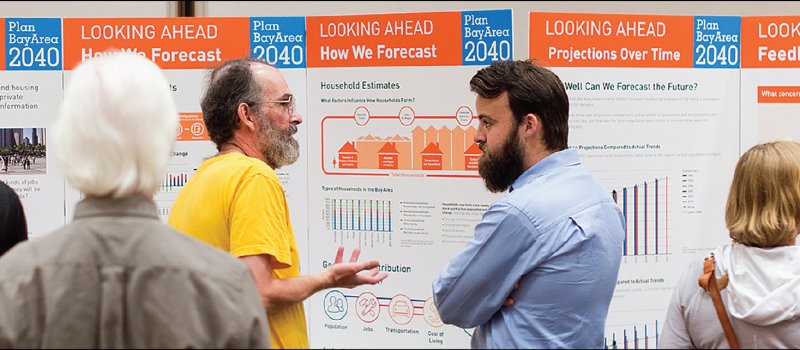
Planning officials will soon weigh public input gathered at spring open houses promoting Plan Bay Area 2040, the update to the regional transportation and land-use roadmap that’s underway.
The Metropolitan Transportation Commission (MTC) and Association of Bay Area Governments (ABAG) will review a summary of public comments at a June 12 joint committee meeting, the first of several confabs to refine future growth goals and targets.
An estimated 520 individuals collectively attended eight open houses held in each county this spring, said Ellen Griffin, MTC spokesperson. Numbers for the ninth open house, scheduled in Marin County at the end of May, were not available at press time. For those who couldn’t attend meetings, a Plan Bay Area online forum was created to collect additional comments during the month of May.
Attendees were asked to critique the seven goals and targets laid out in the initial Plan Bay Area, adopted by MTC and ABAG in July 2013. Those goals are: climate protection, adequate housing, healthy and safe communities, open space and agricultural preservation, equitable access, economic vitality, and transportation system effectiveness. They could talk about goals that align with their own priorities, or offer new ideas altogether.
“So far we are seeing the strongest support for an effective transportation system and adequate housing supply,” Griffin said in an e-mail.
Deciding whether adequate housing, transit, and the other current goals should be “modified” is one of the first actions MTC and ABAG are expected to take this fall, Griffin said.
Overall, the approach to the update “is to be limited and strategic,” added MTC Planning Director Ken Kirkey. “Plan Bay Area is a big undertaking, and many people and partners put a lot of work into the first plan.”
In adherence to state legislation passed in 2008, Plan Bay Area blends two regional plans: MTC’s transportation plan and ABAG’s housing plan. The legislation requires the Bay Area and California’s 17 other metropolitan areas to have in place strategies that accommodate future housing growth and improve public transit, while cutting greenhouse gas emissions from cars and light trucks. Plan Bay Area is updated every four years, with the next iteration slated for adoption in 2017.
No matter the timeframe, certain realities continue to pose challenges. One is the nearly 30 percent population jump expected over the next 25 years across the nine counties. This growth gives the Bay Area the distinction of California’s second-largest population and economic center, and drives home the need for decision makers to delve into housing affordability, transit modernization, agricultural land preservation, and sea level rise, among other hot issues, public advocates said.
Urban Habitat’s Bob Allen, director of the group’s policy and advocacy campaigns, cautioned that the region “can’t afford an update as usual” to Plan Bay Area. He cited climate change and housing displacement among struggling families as some of his key concerns.
Clarrissa Cabansagan, community planner at TransForm, said she was concerned about the potential for new developments to undermine smart growth goals.
“We can plan for growth around a transit station, but it matters who can and cannot afford to live there,” she said. “When we require each home near transit to still have two parking spots, that adds to the cost of housing and doesn’t encourage people to drive less.”
The current Plan Bay Area focuses almost 80 percent of homes and 60 percent of jobs in areas well served by transit, so it’s important to strengthen transit services in areas with the most opportunities for infill development, said Matt Vander Sluis, program director at Greenbelt Alliance.
Vander Sluis said he’d like to see MTC double the size of its Priority Conservation Area Grant Program to $10 million to better protect natural and agricultural lands through transportation investments that prevent sprawl.
“I think the drought will reinforce the notion that we can’t continue to sprawl outward, and, to protect our drinking water supplies, we need to grow smartly with more transit choices,” Vander Sluis said.
Going forward, there will be several opportunities to follow and weigh in on updates, including joint committee meetings scheduled by MTC and ABAG on July 10 and September 11.
In addition to public input, certain pilot projects and studies could influence updates as well, Kirkey said. This includes a climate adaptation pilot study that identified critical Alameda County areas vulnerable to climate change and in need of levees to reduce flooding and offer protection. Meanwhile, a core capacity transit study is exploring solutions to improve coordination between Bay Area transit operators.
Cecily O’Connor covers transportation for the Monitor.